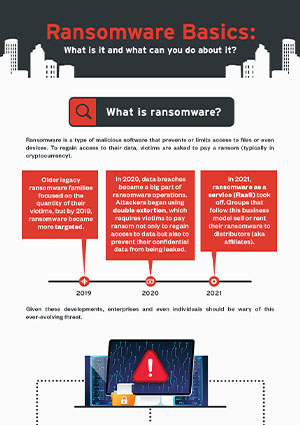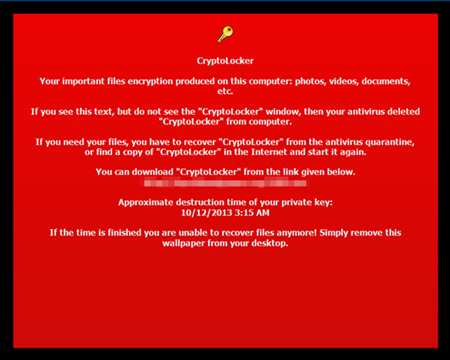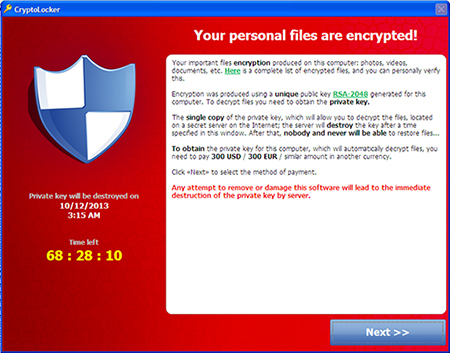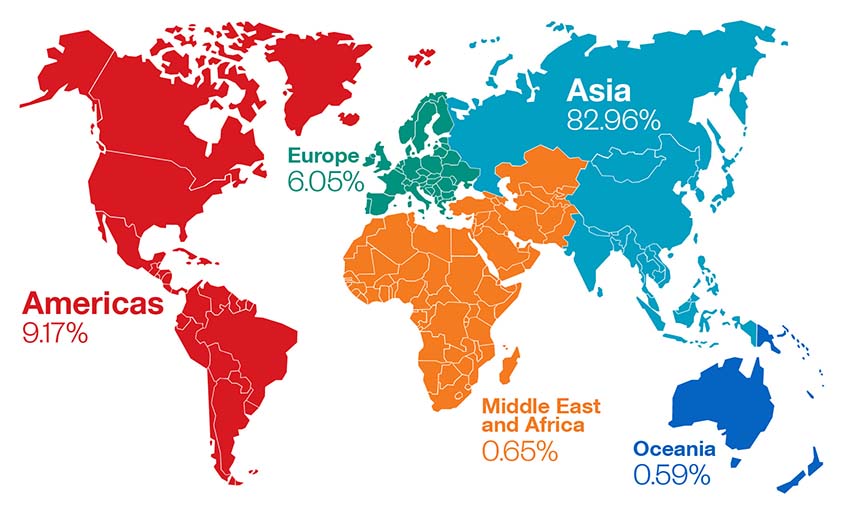Ransomware
 View infographic: Ransomware Basics: What is it and what can you do about it?
View infographic: Ransomware Basics: What is it and what can you do about it?
Ransomware Definition
Ransomware is a type of malware that prevents or limits users from accessing their system, either by locking the system's screen or by locking the users' files until a ransom is paid. More modern ransomware families, collectively categorized as cryptoransomware, encrypt certain file types on infected systems and force users to pay the ransom through certain online payment methods to get a decryption key.
Ransom Prices and Payment
Ransom prices vary depending on the ransomware variant and the price or exchange rates of digital currencies. Thanks to the perceived anonymity offered by cryptocurrencies, ransomware operators commonly specify ransom payments in bitcoin. Recent ransomware variants have also listed alternative payment options such as iTunes and Amazon gift cards. It should be noted, however, that paying the ransom does not guarantee that users will get the decryption key or unlock tool required to regain access to the infected system or hostaged files.
How Does Ransomware Spread
Users might encounter this threat through a variety of means. Ransomware can be downloaded onto systems when unwitting users visit malicious or compromised websites. It can also arrive as a payload that is either dropped or downloaded by other malware. Some ransomware are delivered as attachments from spammed email, downloaded from malicious pages through malvertisements, or dropped by exploit kits onto vulnerable systems.
Once executed in the system, ransomware can either lock the computer screen or, in the case of cryptoransomware, encrypt predetermined files. In the first scenario, a full-screen image or notification is displayed on an infected system's screen, which prevents a victim from using their system. This notification also details instructions on how a user can pay the ransom. In the second scenario, ransomware prevents access to potentially critical or valuable files like documents and spreadsheets.
Ransomware is considered "scareware" as it forces users to pay a fee (or ransom) by scaring or intimidating them. In this sense, it is similar to FakeAV malware, but instead of capturing the infected system or encrypting files, FakeAV shows fake antimalware scanning results to coax users into purchasing bogus antimalware software.
How to Prevent Ransomware Attacks
To protect yourself and your system from ransomware, follow these recommended steps:
- Avoid opening unverified emails or clicking links embedded in them.
- Back up important files using the 3-2-1 rule: Create three backup copies on two different media with one backup in a separate location.
- Regularly update software, programs, and applications to protect them from the latest vulnerabilities.
- Create a culture of security and equip personnel with adequate knowledge on ransomware and other threats that utilize phishing and unsecure accounts in their campaigns.
- Enforce the principle of least privilege to prevent users from running certain programs that can be used by ransomware variants.
- Limit access to shared or network drives and turn off file sharing. This minimizes the risk of a ransomware infection spreading to other devices.
Organizations can also mitigate the effects of public shaming dealt by the conditions of ransomware’s double extortion scheme by being responsible and taking the following steps:
- Notify law enforcement about the attack and the extent of the data breach.
- Follow data regulation protocols such as the General Data Protection Regulation (GDPR) and make the necessary disclosures and notifications.
- Prevent similar attacks from succeeding by addressing the security issues exploited by the attack.
Latest Ransomware News
- Ransomware Spotlight: Ransomhub
- From Vulnerable to Resilient: Cutting Ransomware Risk with Proactive Attack Surface Management
- The Easy Way In/Out: Securing The Artificial Future
- Ransomware Spotlight: INC
- Phobos Emerges as a Formidable Threat in Q1 2024, LockBit Stays in the Top Spot: Ransomware in Q1 2024
The History and Evolution of Ransomware
Early Years
Cases of ransomware infection were first seen in Russia between 2005 and 2006. Trend Micro published a report on a case in 2006 that involved a ransomware variant (detected as TROJ_CRYZIP.A) that zipped certain file types before overwriting the original files, leaving only the password-protected zip files in the user’s system. It also created a text file that acted as the ransom note informing users that the files can be retrieved in exchange for US$300.
In its earlier years, ransomware typically encrypted particular file types such as .doc, .xls, .jpg, .zip, .pdf, and other commonly used file extensions.
In 2011, Trend Micro published a report on an SMS ransomware threat that asked users of infected systems to dial a premium SMS number. Detected as TROJ_RANSOM.QOWA, this variant repeatedly displayed a ransomware page to users until they paid the ransom by dialing a certain premium number.
Another notable report involved a ransomware type that infects the Master Boot Record (MBR) of a vulnerable system, preventing the operating system from loading. To do this, the malware copies the original MBR and overwrites it with malicious code. It then forces the system to restart so that the infection takes effect and displays the notification (in Russian) once the system restarts.
Ransomware Spreads Outside Russia
Ransomware infections were initially limited to Russia, but due to ransomware’s popularity and profitable business model, it soon found its way to other countries across Europe. By March 2012, Trend Micro observed a continuous spread of ransomware infections across Europe and North America. Similar to TROJ_RANSOM.BOV, this new wave of ransomware displayed a notification page (supposedly from the victim’s local police agency) instead of the typical ransom note (discussed more thoroughly in the section titled “The Rise of Reveton and Police Ransomware”).
During this period, different tactics were used to spread ransomware. A case in 2012 involved the website of a popular French confectionary that was compromised to serve TROJ_RANSOM.BOV. This watering hole tactic resulted in widespread infections both in France and Japan, where the shop also had significant fan bases. It is also worth noting that instead of the usual ransom note, TROJ_RANSOM.BOV displayed a fake notice from the French police agency, Gendarmerie Nationale.
The Rise of Reveton and Police Ransomware
Reveton is a ransomware type that impersonates law enforcement agencies. Known as “police ransomware” or “police trojans,” these malware are notable for showing a notification page purportedly from the victim’s local law enforcement agency. This page informs them that they were caught doing an illegal or malicious activity online.
To know which local enforcement agency is applicable to users, Reveton variants track the geographical location of their victims. Thus, affected users living in the US receive a notification from the FBI, while those located in France are shown a notice from the Gendarmerie Nationale.
Reveton variants also employ a different payment method compared to early ransomware attacks. Once a system is infected with a Reveton variant, users are prompted to pay through UKash, PaySafeCard, or MoneyPak. These payment methods afford ransomware perpetrators their anonymity, as both Ukash and PaySafeCard have a faint money trail.
In 2012, different types of Reveton variants were seen exhibiting new techniques. In the latter part of the same year, Trend Micro reported on variants that played an audio recording using the victim’s native language, as well as another variant that used a fake digital certificate.
The Evolution to CryptoLocker and Cryptoransomware
In late 2013, a new type of ransomware that encrypted files aside from locking a system emerged. The encrypted files ensured that victims were forced to still pay the ransom even if the malware itself was deleted. Due to its new behavior, it was dubbed as “CryptoLocker.” Like previous ransomware types, cryptoransomware demands payment from affected users in exchange, this time, for a decryption key to unlock the encrypted files.


Although the ransom note in CryptoLocker only specifies “RSA-2048” as the encryption method used, analysis shows that the malware uses AES + RSA encryption.
RSA is asymmetric key cryptography, which means it uses two keys. One key is used to encrypt the data and another is used to decrypt the data (one key, called the public key, is made available to any outside party; the other is kept by the user and is called the private key.) AES uses symmetric keys, which means that it uses the same key to encrypt and decrypt information.
The malware uses an AES key to encrypt files. The AES key for decryption is written in the files that are encrypted by the malware. However, this key is encrypted with an RSA public key embedded in the malware, which means that a private key is needed to decrypt it.
Further research revealed that a spam campaign was behind the CryptoLocker infections. The spammed messages contained malicious attachments that belonged to TROJ_UPATRE, a malware family characterized by its small file size and simple downloading function — it downloads a ZBOT variant, which then downloads the CryptoLocker malware.
Near the end of 2013, a new variant of CryptoLocker emerged — this time, with propagation routines. This variant, detected as WORM_CRILOCK.A, can spread via removable drives, a routine unheard of in other CRILOCK variants. This means that the malware can easily spread compared to other variants. Additionally, it does not rely on downloader malware like CRILOCK to infect systems; rather, it pretends to be an activator for software used on peer-to-peer (P2P) file-sharing sites. Technical differences have led some researchers to believe that this malware was produced by a copycat.
Afterward, another file-encrypting ransomware type soon came into the picture. The cryptoransomware known as CryptoDefense or CryptorBit (detected as TROJ_CRYPTRBIT.H) encrypts database, web, office, video, image, script, text, and other non-binary files. It also deletes backup files to prevent the restoration of encrypted files and demands payment for a decryption key for the locked files.
Files to Encrypt
Earlier cryptoransomware types targeted .doc, .xls, .jpg, .zip, .pdf, and other commonly used files to encrypt them. Cybercriminals have since included a number of other file types that are critical to businesses, like database files, website files, SQL files, tax-related files, CAD files, and virtual desktop files.
The Foray into Cryptocurrency Theft
Ransomware soon began to incorporate yet another element: cryptocurrency (such as bitcoin) theft. In 2014, Trend Micro saw two variants of a new malware called BitCrypt. The first variant, TROJ_CRIBIT.A, appends “.bitcrypt” to any encrypted files and displays a ransom note in English. The second variant, TROJ_CRIBIT.B, appends the file name with “.bitcrypt 2″ and uses a multilingual ransom note in 10 languages. CRIBIT variants use the encryption algorithms RSA(426)-AES and RSA(1024)-AES to encrypt the files and specifies that the payment for unlocking files be made in bitcoins.
It was also discovered that a variant of the Fareit information stealing malware, TSPY_FAREIT.BB, downloads TROJ_CRIBIT.B. This Fareit variant can steal information from various cryptocurrency wallets, including wallet.dat (Bitcoin), electrum.dat (Electrum), and .wallet (MultiBit). These files contain important information such as transaction records, user preferences, and accounts.
The Bitcoin Connection
With the exception of some ransomware families that demand high amounts, ransomware variants typically ask for 0.5 to 5 bitcoins (as of 2016) in exchange for a decryption key. This is important to note for two reasons: First, some variants increase the ransom the more time lapses that it remains unpaid. Secondly, the Bitcoin exchange rate is on the rise. In January 2016, one bitcoin was worth US$431. Bitcoin's value has risen dramatically since then, topping out at US$20,217.10 as of July 5, 2022, 4:15 AM UTC.
Ransomware as a Service
When the ransomware as a service (RaaS) model entered the picture, it made it easier for a variety of attackers, even those who have little technical knowledge, to wield ransomware against targets. RaaS involves selling or renting ransomware to buyers who are called affiliates, and this model can be credited as one of the primary reasons why ransomware attacks have been proliferating rapidly.
The RaaS-operating criminal group first needs to develop or acquire the ransomware software and infrastructure. They then proceed to recruit affiliates through online forums, Telegram channels, or personal connections, with some operators investing as much as US$1 million for recruitment efforts. Once enlisted, affiliates can then launch their own attacks. RaaS provides a win-win situation and a high payout for both operators and affiliates. Affiliates can earn payouts without having to develop the ransomware themselves, while operators can directly make a profit from their affiliates. The payouts are normally organized using a revenue model for RaaS subscriptions. The possible revenue models besides subscription are one-time payments, profit sharing, and affiliate marketing.
What is Modern Ransomware
After the shift to cryptoransomware, extortion malware has continued to evolve, adding features such as countdown timers, ransom amounts that increase over time, and infection routines that enable them to spread across networks and servers. Threat actors continue experimenting with new features, such as offering alternative payment platforms to make ransom payments easier, routines that threaten to cause potentially crippling damage to non-paying victims, or new distribution methods, all of which are part of what makes a modern ransomware attack.
Targeted Ransomware and Double Extortion
These developments eventually lead to the appearance of targeted ransomware. Targeted ransomware is also known as big-game hunting and human-operated attacks. By taking a targeted approach, threat actors have found a new way of revitalizing ransomware variants. As with targeted attacks, modern ransomware variants are tailored for specific victims and take more preparation and research. This means that threat actors have had to narrow down their targets to entities that are more likely to lead to bigger payoffs if attacked.
Watch to learn how threat actors, such as those behind Nefilim, launch targeted ransomware attacks
Present iterations of targeted ransomware have the added challenge of double extortion. Through their targeted approach, threat actors come to know which data is most valuable to their targets. By adding double extortion to their attacks, they coerce their victims into complying with their demands. Threat actors force victims into compliance not only by encrypting files but also by threatening to publicize stolen sensitive data if their demands are not met.
The following are some of the most notable modern ransomware groups in 2022:
Conti is reportedly the successor of Ryuk. Known as one of the most notorious ransomware groups in history, Conti had the highest number of victim counts among its counterparts from November 2019 to March 2022, amassing 805 victim organizations. Following a Ukrainian researcher’s leak of some of the ransomware group’s files on March 2, 2022, Conti started shutting down their operations. In June 2022, the ransomware operation has reportedly shut down its last public-facing infrastructure.
LockBit, which version 2.0 surfaced in July 2021, is capable of automatic encryption of devices across Windows domains by abusing Active Directory (AD) group policies, prompting the operators behind it to claim that it’s one of the fastest ransomware variants in the market today. In the period of Q1 2022, LockBit had the most number of victim organizations among double extortion ransomware groups, claiming 220 successfully breached organizations. The ransomware group released LockBit 3.0 in June 2022. One of the significant things about the release of LockBit 3.0 is the announcement of a bug bounty program.
BlackCat has successfully compromised at least 60 organizations around the world as of March 2022. BlackCat is notable for being the first professional ransomware family to be written in Rust, which is considered a more secure programming language that is capable of concurrent processing. As a cross-platform language, Rust also makes it easier for threat actors to tailor malware to different operating systems like Windows and Linux.
Black Basta has garnered notoriety for its attacks on 50 organizations around the world and its use of double extortion since it became operational in April 2022. The ransomware group continues to improve its tactics and techniques: In June 2022, the group was found using the banking trojan QakBot as a means of entry and movement, and taking advantage of the PrintNightmare vulnerability (CVE-2021-34527) to perform privileged file operations.
AvosLocker emerged in July 2021. It started to make a name for itself in early 2022, seemingly filling the void left by REvil. US Federal Bureau of Investigation (FBI) released an advisory on AvosLocker for it has been observed targeting critical infrastructure in different sectors of the US. In May 2022, AvosLocker operators were found abusing a driver file to disable antivirus solutions and scanning for Log4Shell, the Apache Log4j remote code execution (RCE, with ID CVE-2021-44228) vulnerability.
Clop got on the double extortion bandwagon in 2020, when its operators publicized the data of a pharmaceutical company. Since then, the ransomware’s extortion strategies have become progressively devastating, such as going after top executives and customers.
[Read: Latest ransomware articles]
The Biggest Attack to Date
Though ransomware routines are not altogether new, they still work and so are still used by operators. Case in point: The ransomware variant WannaCry (aka WCry), which originally spread via malicious Dropbox URLs embedded in spam, took an unexpected turn in May 2017, when it began exploiting a recently patched vulnerability in the Server Message Block (SMB). In turn, this has led to the biggest ransomware attack to date and, in 2020, WannaCry remained one of the most detected ransomware families across the globe.
Even before WannaCry reared its ugly head, companies and individuals worldwide had already been suffering the dire consequences of such threats. We document all of this in our report titled, “Ransomware: Past, Present, and Future.
2020 regional distribution of ransomware threats based on Trend Micro detection
The Future of Ransomware
Were ransomware to change in a few years, it would not be surprising. In terms of potential, they can evolve into malware that disable entire infrastructures until a ransom is paid. It is worth emphasizing that these infrastructures could be critical not only to a business’s operation, but also to that of a city or even a nation. Cybercriminals might also soon further develop attacks on industrial control systems (ICSs) and other critical infrastructures to paralyze not just networks but also ecosystems. At present, ransomware campaigns are already taking on high-profile and critical targets in the healthcare, transportation, and government sectors.
Organizations need to be prepared for the possibility of more threat actors or groups shifting to and joining the ransomware bandwagon. The theme of double extortion seems to indicate how ransomware operators will continue to find new ways of increasing the stakes for their victims and cornering them into meeting their demands instead of just walking away. Legitimate tools or living-of-the-land components will likely continue to be part of attacks in the future, with threat actors choosing key components based on the profile of their targets.
With enough preparation and by using the techniques of targeted attacks, cybercriminals might aim for even bigger targets, like the industrial robots that are widely used in the manufacturing sector, or the infrastructures that connect and run today’s smart cities. Online extortion is bound to develop from taking computers and servers hostage to eventually doing the same to any type of insufficiently protected connected device, including smart devices and critical infrastructures. The return on investment (ROI) and opportunities for development that the targeted approach has opened will ensure that it continues in the future.
Ransomware Solutions
Although there is no silver bullet with regard to stopping ransomware, a multilayered approach that prevents it from reaching networks and systems is the best way to minimize the risk.
For enterprises, email and web gateway solutions such as Trend Micro™ Deep Discovery™ Email Inspector and Trend Micro™ InterScan™ Web Security prevent ransomware from reaching end users. At the endpoint level, Trend Micro Smart Protection Suites features behavior monitoring and application control, as well as vulnerability shielding to minimize the risk of getting infected by ransomware threats. Trend Micro Deep Discovery Inspector detects and blocks ransomware on networks, while Trend Micro™ Deep Security stops ransomware from reaching enterprise servers — whether physical, virtual, or in the cloud.
Organizations can also consider Trend Micro Cloud One™ – Workload Security, which has a virtual patching feature that can protect the system from exploits. Since some of the malware’s techniques can bypass signature-based security agents, technologies like Trend Micro Behavior Monitoring and Machine Learning (ML) can be used to prevent and block those threats.
Enterprises can also take advantage of Trend Micro XDR, which collects and correlates data across endpoints, emails, cloud workloads, and networks, providing better context and enabling investigation in one place. This, in turn, allows teams to respond to similar threats faster and detect advanced and targeted threats earlier.
For small and medium-sized businesses, Trend Micro Worry-Free Services Advanced offers cloud-based email gateway security through Trend Micro™ Hosted Email Security. Its endpoint protection also delivers several capabilities such as behavior monitoring and a real-time web reputation service that detects and blocks ransomware.
For home users, Trend Micro Security 10 provides robust protection from ransomware by blocking malicious websites, emails, and files associated with this threat.
Trend Micro offers free tools such as the Machine Learning Assessment Tool that provides endpoint security preventing threats from entering the network and the Anti-Threat Toolkit (ATTK) that scans potentially compromised machines for ransomware and other forms of malware.
Notable ransomware families
| Family Name | Notable Features |
| Conti | The distribution and execution of the ransomware payload are done via the creation and execution of scheduled tasks on remote systems. |
| REvil | After execution, REvil can perform several steps, including: privilege escalation via CVE-2018-8453 and decryption of its JSON configuration file to identify elements that will dictate how it will proceed with its routines. |
| BlackCat (aka ALPHV) | Coded in the Rust programming language, the operators of this ransomware is infamous for employing multilevel extortion techniques. |
| Nefilim | Its code shares many notable similarities to that of the Nemty 2.5 ransomware. It uses several legitimate tools and has data exfiltration capabilities used for its double extortion tactics. |
| LockBit | Automatically encrypts devices across Windows domains by abusing Active Directory (AD) group policies. |
| Hive | The operators of this double extortion ransomware primarily targeted the US in 2021, with victim organizations mostly coming from the real estate, IT, and manufacturing industries. |
| RansomExx (aka Exx) | Upon execution, the RansomExx Linux version calls a function referred to as GeneratePreData, which is responsible for the creation of a 256-bit AES key using both pseudo-random values from native Linux functions and mbedtls operations. |
| Clop | FIN11 used a web shell to exfiltrate data from FTA and deliver the Clop ransomware as a payload. |

